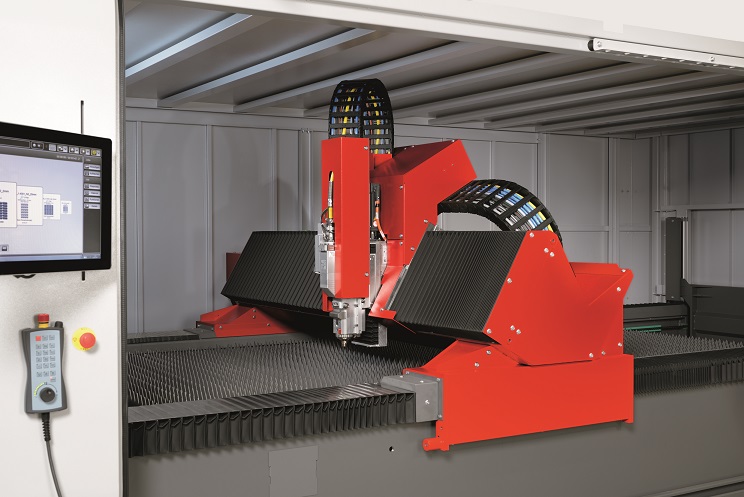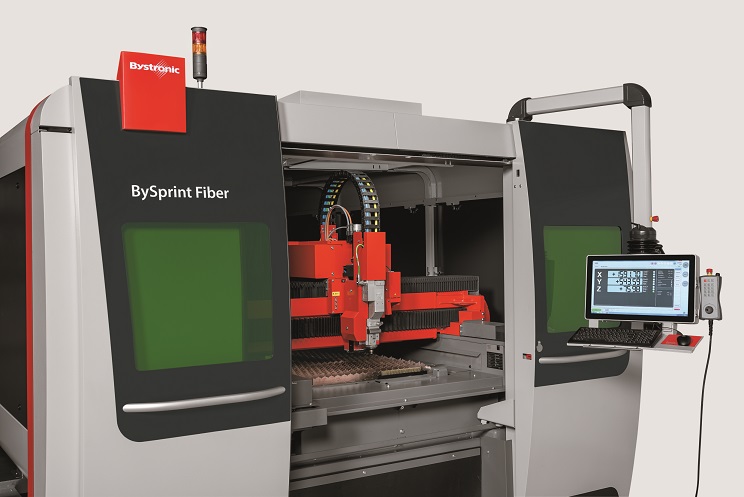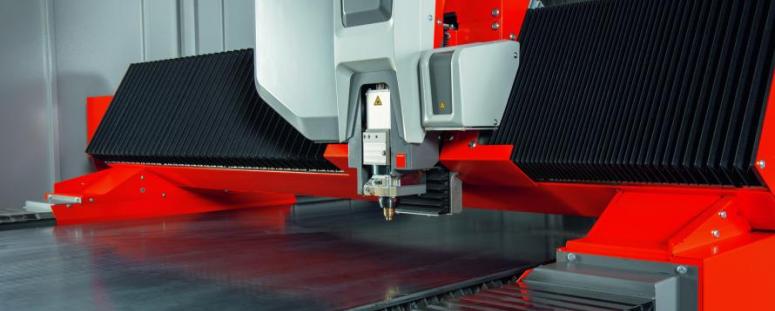When purchasing a laser cutting system, there are a number of things to consider, this goes far beyond the purchase price or service intervals. But what exactly has to be taken into consideration? This guideline might help.
Article proposed by the Bystronic company.
1- What are the differences between a CO2 laser and a fiber laser?
As the name suggests, the CO2 laser uses a gas mixture that is based on carbon dioxide. This mixture, which usually consists of CO2, nitrogen, and helium, is electrically excited to generate the laser beam. Solid-state lasers are available in the form of fiber or disk lasers in similar power levels to their CO2 counterparts. As with the CO2 laser, the laser-active medium gives the fiber laser its name, which in this case is a glass-like or crystalline solid in the form of a fiber or a disk.
While with the CO2 laser, the laser beam is guided through a beam path using optics, the beam of the fiber laser is generated in an active fiber and guided to the machine’s cutting head via a transport fiber. One of the key differences, apart from the laser medium as such, is its wavelength: With a fiber laser the laser wavelength is around 1µm and with a CO2 laser 10µm. The fiber laser’s shorter wavelength results in a higher absorption rate when cutting steel, stainless steel, and aluminum. A higher absorption rate means lower heat generation in the material that is being processed, which is, of course, a positive attribute.
CO2 technology is ideal for all-rounders who process a wide variety of materials and thick metal sheets. A fiber laser cutting system, on the other hand, is capable of processing the thin to thick range of sheet thicknesses with materials ranging from steel, stainless steel, and aluminum, right through to non-ferrous metals (copper and brass).
2- What are the benefits of a fiber laser compared to a CO2 laser?
 The advantage of the CO2 laser is its superior cutting quality in thick steel (mild steel). The fiber laser, on the other hand, offers high cutting speeds and lower operating costs per hour. Fiber lasers require nowhere near as much energy as CO2 lasers, and their electrical efficiency is up to 5 times higher. What is more, the beam path of fiber lasers is simpler. Another big bonus is the more compact footprint: A fiber laser system with 8 to 10 kW laser power requires only about one fifth of the floor space of a CO2 laser system of comparable power.
The advantage of the CO2 laser is its superior cutting quality in thick steel (mild steel). The fiber laser, on the other hand, offers high cutting speeds and lower operating costs per hour. Fiber lasers require nowhere near as much energy as CO2 lasers, and their electrical efficiency is up to 5 times higher. What is more, the beam path of fiber lasers is simpler. Another big bonus is the more compact footprint: A fiber laser system with 8 to 10 kW laser power requires only about one fifth of the floor space of a CO2 laser system of comparable power.
Fiber laser technology has advanced rapidly in recent years. However, it is important to consider more factors than just the laser power and cutting speeds. Success in the sheet metal processing sector is dependent on an entire array of diverse and individual factors, all of which revolve around the core question: What is the optimal workflow? Even the most high-performance machine can only be cost-effective if its potential is fully exploited.
3- What should be considered when purchasing a laser cutting machine?
The factors vary enormously. In order to be able to evaluate which machine is best suited, one must first understand the intended application and define not only its requirements, but also its limits. One should also consider potential new objectives on the horizon and other options. After all, the purchase of a laser cutting system represents a major investment, and the decision concerns not just the machine itself. The purchase has an impact on the entire manufacturing process, covering everything from manpower, service and maintenance, consumables, right through to know-how.
Other factors are also involved: The fiber laser allows companies to increase the speed of a single process step. However, this may make it necessary to automate loading and unloading, since otherwise the machine will frequently be idle because its operators cannot keep up.
The prime objective is clear: Reduce costs while increasing product quality and productivity. Achieving this objective with the purchase of a new system requires know-how that may not yet be available within the company. The capacity and performance of the system must correspond to the needs. If you invest a significant sum in a fiber laser cutting system in combination with complex material management solutions, you naturally expect to achieve a favorable ROI.
4- How has the laser cutting system market developed in recent years?
15 years ago, there were perhaps no more than 20 laser cutting machine OEMs, and the industry was dominated by a handful of leading suppliers. In the meantime, however, the market has opened up, and today, there are a multitude laser cutting machine manufacturers on the market. The number of suppliers of other components, such as software and CNC controls, has also increased dramatically, with the result that virtually anyone with a modicum of know-how can now produce a fiber laser cutting machine.
This development has resulted in the market being flooded with cheap equipment, and this is precisely where the problem lies: Sheet metal processing companies are faced with a large number of new suppliers who have little process knowledge, do not guarantee spare parts availability, and do not offer any customer services, because their only goal is to sell at low costs in order to increase their own market share. This often results in the fact being overlooked that rather than being a plug-and-play solution, a laser cutting system only works when countless components interact flawlessly.
The industry has experienced significant technological advancements over the past 25 years – and major technological rollouts are always challenging.
5- How important is customer service?

Very important! Current fiber technology does not require the same level of maintenance as CO2 technology, but if a machine breaks down, it is imperative to get it back up and running as soon as possible.
CO2 lasers require extensive and time-consuming maintenance. It is not unusual for a service technician to be on site for up to three straight days. CO2 lasers require servicing every 12 months or every 2,000 operating hours. With increasing service life, the overhauls required (for example of the resonator, optical components, and beam path) increase.
In comparison, the maintenance of fiber laser machines is considerably less time and cost intensive. A fiber laser has fewer parts that require maintenance, which translates into real cost and time savings. Thus, the time required for maintenance and inspection of fiber lasers is significantly reduced and usually takes just a few hours.
However, both laser technologies require the service intervals to be adapted in the event of shift operation. Naturally, a laser cutting machine that is in operation 24/7 requires more frequent overhauls. This has an impact on both the maintenance costs and the downtime for servicing.
At the end of the day, the choice of a laser cutting machine should be based not only on the purchase price, but also on the total cost of ownership, calculated over the machine’s entire service life. Maintenance and energy costs as well as machine downtime should definitely be factored in. The energy costs, which can make up a considerable portion of the total annual expenses, are significantly lower with fiber lasers.
For all these reasons, potential buyers should obtain information about the availability and supply of spare parts, so their machine can be promptly repaired in the event of a breakdown. They should also clarify whether the supplier has a service technician stationed nearby who speaks their language.
When you use sophisticated, highly complex technologies, you have to reckon with hiccups. A laser cutting machine that is unable to cut because of a single damaged part is simply not an asset for the customer.
6- What is the service life of a laser cutting machine?
A laser cutting machine can last a long time, provided that a few points are observed:
A suitable environment for the machine (air temperature and humidity), regular cleaning, and above all regular and professional maintenance are essential. These are the basic factors that ensure a long service life.
7- How much must one be prepared to invest?
There is no simple answer to this question, because it depends on so many factors. As previously mentioned, the demands you place on the laser cutting machine play a key role. This has an impact on the size and capacity of the system. The peripheral equipment is also an aspect that must be considered: For example, do the workflows require an automatic loading and unloading system?
If you decide to buy a laser cutting machine, you should not only focus on the costs of the purchase itself, but also evaluate the total cost of ownership, calculated over the machine’s entire service life, including maintenance costs and machine downtime.
In addition, your staff’s current technical skills and their training needs must also be addressed.
Companies that do not consider these factors often make decisions that can have dire and long-lasting consequences: They choose a cheap system. Poor quality, the lack of know-how and experience, no spare parts, and poor service can, in the worst case, rapidly shut down the entire production process.
An integrated concept that takes into account all the points mentioned above is absolutely essential. In the final analysis, it is a matter of working in partnership to find the optimal solution for you. Because only a satisfied customer is a good customer.
Metal-Interface takes great care to protect your privacy: when you submit a request or ask a question, your personal information is passed on to the supplier concerned or, if necessary, to one of its regional managers or distributors, who will be able to provide you with a direct response. Consult our Privacy Policy to find out more about how and why we process your data, and your rights in relation to this information. By continuing to browse our site, you accept our terms and conditions of use.
 2D Laser cutting Technical article
2D Laser cutting Technical articleWhat is important when buying a laser cutting machine?
